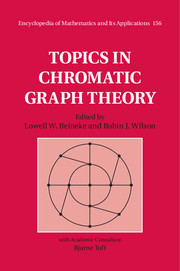Book contents
- Frontmatter
- Contents
- Foreword
- Preface
- Preliminaries
- 1 Colouring graphs on surfaces
- 2 Brooks's theorem
- 3 Chromatic polynomials
- 4 Hadwiger's conjecture
- 5 Edge-colourings
- 6 List-colourings
- 7 Perfect graphs
- 8 Geometric graphs
- 9 Integer flows and orientations
- 10 Colouring random graphs
- 11 Hypergraph colouring
- 12 Chromatic scheduling
- 13 Graph colouring algorithms
- 14 Colouring games
- 15 Unsolved graph colouring problems
- Notes on contributors
- Index
- References
15 - Unsolved graph colouring problems
Published online by Cambridge University Press: 05 May 2015
- Frontmatter
- Contents
- Foreword
- Preface
- Preliminaries
- 1 Colouring graphs on surfaces
- 2 Brooks's theorem
- 3 Chromatic polynomials
- 4 Hadwiger's conjecture
- 5 Edge-colourings
- 6 List-colourings
- 7 Perfect graphs
- 8 Geometric graphs
- 9 Integer flows and orientations
- 10 Colouring random graphs
- 11 Hypergraph colouring
- 12 Chromatic scheduling
- 13 Graph colouring algorithms
- 14 Colouring games
- 15 Unsolved graph colouring problems
- Notes on contributors
- Index
- References
Summary
Our book Graph Coloring Problems [85] appeared in 1995. It contains descriptions of unsolved problems, organized into sixteen chapters. A large number of publications on graph colouring have appeared since then, and in particular around thirty of the 211 problems in that book have been solved. In this chapter we review some of our favourite problems that remain unsolved.
Introduction
A main reason for the continued interest in the area of graph colouring is its wealth of interesting unsolved problems. Many of these are easy to state, but seemingly difficult to solve. However they are not impossible, as the literature in the field will testify.
The seven most striking results of the past twenty years are:
• the 5-list-colourability of planar graphs (dating back to V. G. Vizing in 1975 and to P. Erdős, A. L. Rubin and H. Taylor in 1979) by Thomassen [159]
• the confirmation by Robertson, Sanders, Seymour and Thomas [137] of the truth of the four-colour theorem (F. Guthrie and A. De Morgan (1852))
• the asymptotic solution by Reed [134] of the problem as to whether for k ≥ 9 there are k-chromatic graphs without complete k-graphs and of maximum degree k (V. G. Vizing (1968) and O. V. Borodin and A. V. Kostochka (1977))
• the proof by Chudnovsky, Robertson, Seymour and Thomas [39] of the strong perfect graph conjecture of C. Berge around 1960
• the proof by Thomassen [161] of the weak 3-flow conjecture of W. T. Tutte (1954) and F. Jaeger (1988)
• the solution by Kostochka and Yancey [111] to the problem of critical graphs with few edges (due to T. Gallai (1963) and O. Ore (1967))
• the description found by Borodin, Dvořák, Kostochka, Lidický and Yancey [24] of all 4-critical planar graphs with exactly four triangles (B. Grünbaum (1963), V. A. Aksenov (1974) and P. Erdős (1990)).
In addition to these major achievements there are many other important results – in fact, thirty-one of the original 211 problems from the lists in Jensen and Toft [85] were solved by 2013.
- Type
- Chapter
- Information
- Topics in Chromatic Graph Theory , pp. 327 - 357Publisher: Cambridge University PressPrint publication year: 2015
References
- 1
- Cited by

